Site Menu:
| This is an archived Horseadvice.com Discussion. The parent article and menus are available on the navigation menu below: |
| HorseAdvice.com » Diseases of Horses » Lameness » Diseases of the Hoof » Founder & Laminitis » Founder & Laminitis an Overview » |
| Discussion on Laminitis in a 5-month-old Foal -- Second Opinion | |
| Author | Message |
| New Member: ksnively |
Posted on Monday, Oct 27, 2008 - 10:59 am: Saturday, 10/18 our 5-month-old foal was noted to be lame in the front on both sides. That night, the veterinarian came out to see him. She noted that with using the hoof tester, he was positive in both front hooves. She did a nerve block on the right hoof and after that, he was not lame in the right, but very lame in the left. She did x-rays of both the right and left front hoof. She noted that his toes were long (although he was trimmed 8 weeks ago) and his heels were short. She said he did not have founder, as there was no rotation, but possibly laminitis, which she said was very unusual for a 5-month-old. Right now, he is on stall rest. We would only bring him out to mud soak him for 20 minutes each day and put a pad on the heel of each front foot. The farrier came out that Monday to trim his toe and said nothing could be done for his heel because that was just his conformation. He was getting 1 gm of phenylbutazone a day, which on Wednesday and Thursday was cut back to 0.5 gm and starting Friday we stopped the bute. He did well through the weekend, although during this time he did continue to have heat in both front hooves. We continued with the soaking and wrapping for heel support. The vet had said if he continued to do well through the weekend, on Monday we could start with short periods of turnout with his makeshift booties on. This morning I went out to check him and soak/wrap him and he is stiff when walking and does not lead very willingly. His hooves continue to be warm and when I put him on the cross ties to soak him, he was shifting his weight from one foot to the other. The vet had suggested that I give him 0.5 gm of bute, soak/wrap him and if there is not improvement or gets worse today or if there is no improvement tomorrow, she will come out to see him again and we should look into ordering him hoof boots.Attached are the x-rays that were taken. 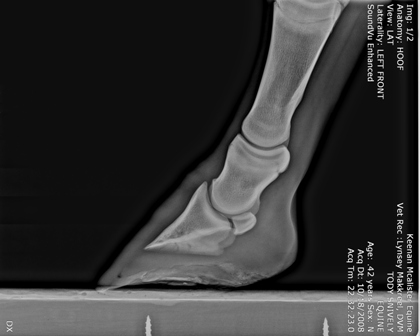 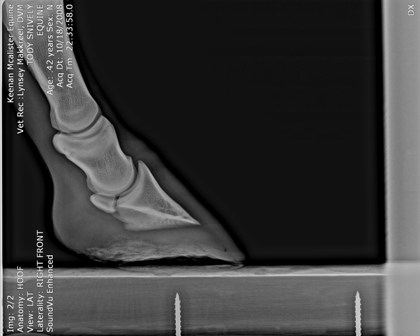 I am at a cross roads. The breeder, who is a friend, says that she has not heard of this happening before with a 5-month-old and everyone she has asked has never heard of it. She would like us to bring him back to her place so that she can try to get him through this, which she said might involve drilling a hole in each of his hooves to release the pockets of gas that the vet says she sees on the x-rays. The vet is saying that as we continue to trim away the hoof, the gas will go away. Any advice you could offer would be greatly appreciated. |
| Moderator: DrO |
Posted on Monday, Oct 27, 2008 - 11:36 am: Welcome Kimberly,The radiographs indicate this foal's feet are long with have overly long toes. I do not see evidence of gas pockets but her images will be clearer than those here. Evident in the radiographs are a thick sole and the solar surface of the coffin bone makes a reverse angle with the ground (the tip is pointed up and should be slightly pointed down)and the heels are run under. How long the reverse angle has been there is hard to say but the run under heels suggest this has been going on a long time. Excessively long toes is a cause of run under heels. The other result of such a conformation is that the pull of the deep digital flexor on the coffin bone and impar ligament are increased along with increase pressure against the back side of the navicular bone. I have seen where such conformation can cause bilateral lameness. The problem is differentiating this from founder and in fact this pull on the coffin bone can cause a mechanical rotation and founder if the DDF tendon pulls the coffin bone away from the hoof wall, something that has not happened yet in these images. Along with standard therapy for founder including the judicious use of NSAID's, I would recommend that you, your vet, and farrier get together and consider the feet be trimmed to correct this imbalance, possibly roll the toe, and it is important this foal be stall rested until sound when off NSAID's. Note well that much of this opinion rests on an assumption the foal was standing square when these images were taken. If not I may change this idea. DrO |
| Member: ajudson1 |
Posted on Monday, Oct 27, 2008 - 2:30 pm: Hi Kimberly,Welcome to HA. Sorry to hear such a young colt is having troubles. If you read on here for a period of time, you will find I am very enthusiastic about trimming myself, and learning about proper trimming, and I can tell ya, it makes me sad to think a 5 month old foal is already a victim of too long toes, run under heals, and possibly these things causing him pain. Keeping those little hoofs properly trimmed, and trimmed often enough will have an impact on his long term soundness. Please take DrO's advice and correct his imbalances and get his toes and heels correct. |
| Member: scooter |
Posted on Monday, Oct 27, 2008 - 3:05 pm: Kimberly thanks for sharing your x-rays, I have heard of negative palmer angle, but have never seen it on x-rays.Dr.O. since the foal is young should addressing this problem be done slowly so as not to stress the tendon even more? Or does the stall rest keep from impacting it so much? Kimberly I hope you have a good vet/farrier team. Could you post pics of his hooves? Good Luck with your little guy I hope he recovers well!! |
| New Member: ksnively |
Posted on Monday, Oct 27, 2008 - 5:37 pm: Dr. O - Thank you for your opinion. After your reply, I looked into run under heels and it makes sense for what our little guy is experiencing. We are going to board him back at the breeder's barn. I have forwarded your response to her and she will be getting her vet involved as well as her farrier. Hopefully we can get this under control.Angie - Thank you for your response. I actually had just picked up Pete Ramey's book on natural hoof care a couple months ago. I haven't had the time to really look into it, but will be making it a priority as we get him back on track. Diane - I will take pictures of his hooves tomorrow when I take off his makeshift booties to soak him. Thank you all for your help and words of encouragement. He really is the sweetest little guy. Here is a picture of him. The picture is from about 2 months ago. Just realized I have been lax in taking pictures of him. He is next to our 5 y/o OTTB. 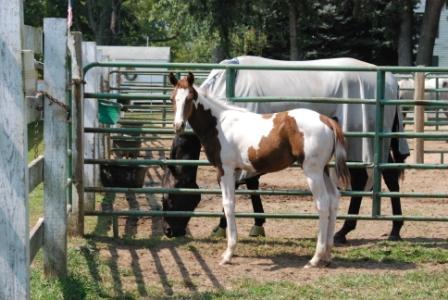
|
| Member: ajudson1 |
Posted on Monday, Oct 27, 2008 - 7:34 pm: He's nice! Looks like a compact little fella, which I just love.Can't tell for sure, but he does seem to look like he's standing under himself a bit in front, and that left hind looks underslung too. I'm no expert on foal's hooves though, and those youngsters always look so gangly and goofy/cute anyhow! Love to see a current picture of how he's standing now. Hope he recovers soon and turns out o.k. |
| Moderator: DrO |
Posted on Tuesday, Oct 28, 2008 - 7:34 am: DianeE,Raising the heels might stress the extensor tendons but they can be quite forgiving. I would attempt to correct this as quick as the solar horn depth allows as I think chronic degenerative changes can be induced by the problems I describe above. DrO |
| New Member: ksnively |
Posted on Tuesday, Oct 28, 2008 - 10:36 am: Here are a couple pictures of Toby's hooves. I couldn't get a good side view of his stance because I was in the wash stall and didn't have enough room for a full side view.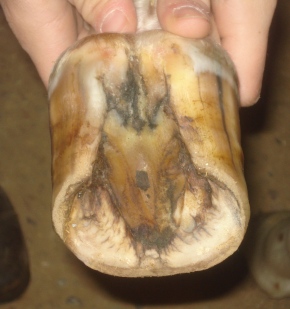 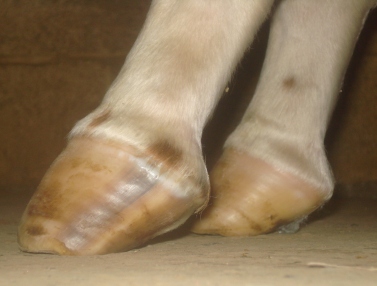 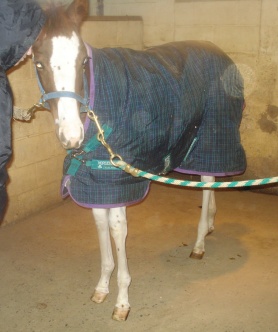
|
| Member: juliem |
Posted on Tuesday, Oct 28, 2008 - 3:10 pm: Well, if that photo is a true representation, his heels are not short! They are underrun and very contracted! But, the radiographs tell a different story! Lowering the heels would make that nagative angle worse I think. I think you need a vet and farrier to work together on this and they need to be an equine vet and a good farrier who understand the inner structures of the foot. Is this colt stalled? Babies that have plenty of room to romp and run don't usually develop feet like this. This guy needs advice from someone "with a higher pay grade" than mine! I think it's possible that the tip of the coffin bone is exerting pressure on the sensitive tissue between it and the wall, thus the reaction to hoof testers. But that's speculation on my part. By the way, welcome to HA and kudos to posting such great photos on your first try!! |
| New Member: ksnively |
Posted on Tuesday, Oct 28, 2008 - 3:22 pm: Hi Julie,He is stalled now due to his problem. Also, he was stalled for 3 weeks from the end of September into the first couple weeks of October due to a soft tissue injury of the shoulder, which healed very well. Prior to that and since that time, he was turned out during the day, stalled for an afternoon nap, turned back out until nighttime and then stalled for the night. |
| Member: scooter |
Posted on Tuesday, Oct 28, 2008 - 5:17 pm: Thanks for the pics Kim! From taking pics of my horses hooves I DO know sometimes they can be deceiving. Has he been trimmed much before? Is the barn he's going back to have the farrier that's been trimming him? I'll be very curious to see what Dr.O. has to say about his hooves. There is a mini up the road with very similar hooves and she is always lame. Wonder how you go about fixing them? and how they got so contracted and under run on such a young guy. Can confirmation contribute to it? |
| Member: ajudson1 |
Posted on Tuesday, Oct 28, 2008 - 6:09 pm: Kim,If I may make a suggestion, there are some good Yahoo groups out there on hoof care. Barefoothoofcare is one, and if you post those pictures, you'd get some good advice, and you could ask for where to look for a good farrier also. I really can't understand how a 5 month old colt can have hoofs like that. Having said that, I haven't had any foals around for about 15 years, and when I did, I didn't pay attention to hoofs like I do now. But those feet don't look good at all. |
| Moderator: DrO |
Posted on Tuesday, Oct 28, 2008 - 9:17 pm: It is clearly seen in both radiographs and now the live pictures the foot is overly long. That by being allowed to become so long the heels have broken down and become underrun. So let's be clear what we mean by raising the heels: they have to be raised with respect to the toe (pick your reference points). Or in other words the foot needs to be tipped forward to correct the remarkable AP imbalance. This does not mean that the heels should be left LONG but instead mean you should RAISE the heel with respect to the ground.Kimberley almost all foals I have ever seen with feet like you yours are lame. There lameness increases with exercise. They are not clearly lame from founder and I believe this is a tendonitis/desmitis problem as some foals with feet like this that remain uncorrected have swollen flexor tendons. But many tissues in hooves like this are stressed so I am just guessing. The most pertinent question becomes, "Is there enough horn to reshape the foot with trimming alone or are appliances going to be required to correct the AP imbalance?". A second question that will follow shortly is will the underrun heels grow straighter. I think the answer to the second question is going to be yes but the answer to the first will have to be done by the farrier with the help of the veterinarian while working on the foot. As much foot as this foal has my guess is yes but it would not floor me in the heels did end up needing some support. DrO |
| New Member: ksnively |
Posted on Wednesday, Oct 29, 2008 - 10:48 pm: Thank you all for your advice. I am in contact with a natural hoof care professional who is coming to our farm tomorrow to see how he can manage Toby. |
| Member: scooter |
Posted on Thursday, Oct 30, 2008 - 6:04 am: Kim, Please let us know what the trimmer thinks. Dr.O. will correct me if I'm wrong I hope, but I think you will need to be pretty precise with his trimming so as to not stress his tendons further.Hope Toby feels better soon, he is a very sweet looking little guy! |
| Member: ajudson1 |
Posted on Thursday, Oct 30, 2008 - 7:54 am: Hi KimI also want to know what the trimmer thinks and what he does. And I want to know if what I am thinking is the correct way, just for my personal knowledge! I'd love to see some pictures as things progress. Also, please be aware anyone can call themselves a natural hoof care professional, and not do the right things. I find it's best to be armed with much info myself. Hope the person works out, Toby is such nice colt. |
| Moderator: DrO |
Posted on Thursday, Oct 30, 2008 - 6:51 pm: I want to second Angie's concern about the term "natural farrier". All good farriers are natural trimmers whether they use shoes or not. Experience is the word I would like see with a good following of equestrians who have horses with good healthy looking feet.Diana, the direction we need these feet to move in will relieve excessive flexor (read that weight bearing) tendon tension. The digital extensors are quite passive during the stressful moments. Carpal extensors can be over burdened so there may be some concern here but as digital flexor stress is relieved it actually decreases pull on the carpal flexors so not to put to blunt a point on it, no I don't think changing tendon stresses is a important point in this particular case. DrO |
Horseadvice.com
is The Horseman's Advisor
Helping Thousands of Equestrians, Farriers, and Veterinarians Every Day
All rights reserved, © 1997 -
is The Horseman's Advisor
Helping Thousands of Equestrians, Farriers, and Veterinarians Every Day
All rights reserved, © 1997 -
